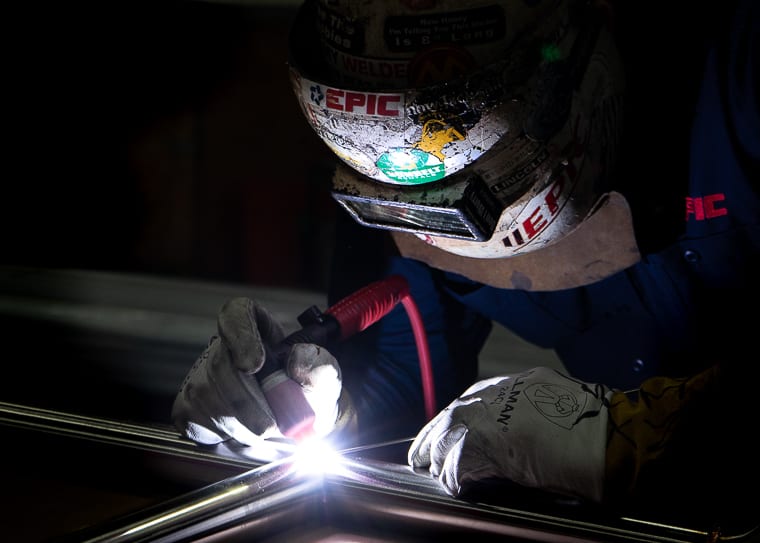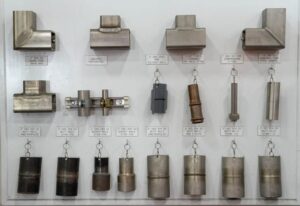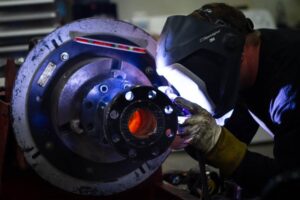Intro to Skid Fabrication Welding
As the saying goes, “There is more than one way to skin a cat”. This is also true of industrial welding. Any skid fabricator worth their salt should be able to tailor welding techniques – arguably the most important step of skid fabrication – to build high-quality systems that exceed client expectations and industry regulations. But verifying your skid fabrication is done correctly can be a daunting task without a basic understanding of these techniques.
What’s that? You’re not a welding expert? That’s okay. This article provides a foundational understanding of the factors to consider when welding for process skid fabrication. We cover common joint types, welding technologies, the benefits of shop welding, welding safety information, and the importance of tracing qualified welding procedures.
Joint Types
For starters, let’s get into joint types. Joint types are the manner in which pieces of pipe, tube, and structural metal are adjoined during a weld. There are several varieties of joint types. Let’s focus on a few we commonly use at EPIC:
- Circumferential Butt Weld: The butting together of two members, end-to-end. Butt welds can be adjoined in two ways. The stronger of the two is the full-penetration weld, in which welding wire fills to the wall thickness of the two adjoining members. The second way is the partial-penetration weld, in which melted wire simply caps the circumference of the adjoined members like a strong piece of tape. For pressure piping and load-carrying structures, it’s best to go with a full-penetration weld.
- Socket (Fillet) Weld: The insertion of a pipe into a socket, followed by the filling of the joint with molten metal to create an air-tight seal.
- Branch Connection Weld: Used for connecting smaller pieces of pipe or tube to the main pipeline, the craftsperson creates a “branch” by drilling a hole into the main pipe and inserting an o-let connector, which he or she welds to the smaller pipe using either a butt or socket weld.
Welding Technologies & When to Use Them
When it comes to welding technologies, there are three basic options from which to choose:
- Gas Tungsten Arc Welding (GTAW): GTAW or Tungsten Inert Gas (TIG) welding allows the welder to assume a greater level of manipulation over their tools when compared to wire-fed technologies. During a TIG weld, the welder lays wire down manually, using a tungsten electrode to melt it into place. Because the welder has more manual control over this welding process, TIG can produce cleaner, higher quality welds. This technology is best suited for sanitary tube and pressure pipe welding.
- Gas Metal Arc Welding (GMAW): Also known as Metal Inert Gas (MIG) welding, this wire-fed technology allows a welder to work quickly and efficiently, feeding the wire through the torch from a spool. Welders can usually lay more wire per minute than is possible with TIG because of the semi-automatic nature of MIG welding. This technology is best suited to pressure pipe welding.
- Flux Core Arc Welding (FCAW): Similar to MIG, this technology utilizes a wire-fed welding torch. However, unlike MIG (which utilizes inert gas as its singular shield) FCAW utilizes an additional shield – flux – that runs through the core of the wire. Because FCAW runs hotter than other welding technologies, the wire penetrates deeper into the base metal allowing for an even stronger weld between two members. This technology is best suited to structural welding.
At EPIC, about 99% of our welding work is either FCAW or TIG. For pressure piping and tubing, our welders operate orbital welding machines, which utilize TIG technology to rotate the arc mechanically 360 degrees to create an even weld as the pipe sits stationary. These machines create high integrity welds in a repeatable fashion.
Benefits of Shop Welding vs. Field Welding
There are circumstances, such as emergency repairs, when field welding is unavoidable. But whenever possible, your equipment should be fabricated in a production shop to ensure high-quality, mistake-free welding. Welding outside is an uphill battle. Whether you’re a full-service modular fabrication firm like EPIC or a simple piping contractor, shop welding is a no-brainer. What do I mean?
Shielding gas is inherently less effective when you’re welding in the elements. It’s nearly impossible to get a decent purge in the wind. You can build an enclosure around your welding area, but that adds time and money. And if the rain decides to come? Delays.
What’s more, when you’re welding to a stationary frame in the field, you’re forced to move around and weld in awkward positions. This is backwards. In a shop, the pipes are adjusted in a rotator, while the welder remains stationary. With plenty of indoor staging space and an arsenal of welding machines, shop welders are afforded more opportunities to weld out of position, which optimizes their efforts by conserving their energy for welding.
Shop welding produces higher integrity welds, ensures deadlines are never missed and relieves welders of unnecessary strain. In particular, we at EPIC have the luxury of engineering and fabricating every aspect of a modular process skid – from the fabrication of pressure piping and load-bearing structures to process controls testing – in a single shop, allowing us to deliver more cohesive and sound process systems to our clients.
Welding Safety
Welding may be mesmerizing to someone passing by due to the bright light and the sound of crackling metal. But without the right safety equipment, you could succumb to severe health issues. Welding arcs give off radiation over a broad range of wavelengths. This includes Ultraviolet (UV) radiation, visible light, and Infrared radiation.
UV-radiation is divided into three ranges – UV-A, UV-B, and UV-C. UV-C and almost all UV-B are absorbed in the cornea of the eye. UV-A passes through the cornea and is absorbed in the lens of the eye. Some UV radiation, visible light, and IR radiation can reach the retina.
Certain types of UV radiation can produce an injury to the surface of the eye called “arc eye,” “welders’ eye” or “arc flash.” These names are common names for “conjunctivitis” – an inflammation of the mucous membrane of the front of the eye. The symptoms include:
- pain – ranging from a mild feeling of pressure in the eyes to intense pain in severe instances
- tearing and reddening of the eye and membranes around the eye
- a sensation of “sand in the eye” or abnormal sensitivity to light
- inability to look at light sources (photophobia)
The amount of time required to cause these effects depends on several factors such as the intensity of the radiation, the distance from the welding arc, the angle at which the radiation enters the eye, and the type of eye protection that the welder or bystander is using. However, exposure to just a few seconds of intense UV light can cause arc eye. These symptoms may not be felt until several hours after exposure.
Long-term exposure to UV light can produce cataracts. Visible light from welding processes is very bright and can overwhelm the ability of the iris of the eye to close sufficiently and rapidly enough to limit the brightness of the light reaching the retina. The result is that the light is temporarily blinding and fatiguing to the eye. A serious concern is the “blue light hazard” which is the temporary or permanent scarring of the retina due to its sensitivity to blue light, around 440 nm wavelength.
EPIC takes many precautions to avoid anyone ever having to deal with the harmful effects of looking directly into an ark. For starters, each one of our Welders has a mask they provide and wear religiously. Also, our shop is lined with red tarps so innocent passersby do not have to wear a mask to be protected from the bright light that is emitted while welding. EPIC’s number one priority is safety when it comes to our modular fabrication shop.
The Importance of Training & Traceability for Skid Fabrication
At EPIC, we qualify our procedures to guidelines set forth by the American Welding Society (AWS) and the American Society of Mechanical Engineers (ASME) for process skid fabrication. We design and fabricate to ASME B31.3 for process piping, ASME B31.1 for power piping and ASME BPE (Bio Processing Equipment) for sanitary tubing. Our clients – who want to be absolutely certain that their process systems are being built on sound welding procedures – appreciate the extra level of pride and care we pour into this.
To ensure fabrication integrity, we have developed Welding Procedure Specifications (WPS). A WPS outlines the pipe thickness, size, material construction, technology used and a number of other specifications to accommodate for the unique requirements of any given project. Before we can qualify a WPS, we must first produce a Procedure Qualification Record (PQR). This is a one-time test used for documenting all the parameters (who the welder is, the type of material, welding process, machine and machine settings, gas flow, purge, etc…) that we used to develop a sample weld called a “coupon.”
Once this coupon is finished, it gets destructively and non-destructively tested by EPIC’s Quality Assurance Manager, Paul Kirksey. Such tests include an X-ray of the weld, cutting it apart, pulling it, bending it and generally testing the weld’s strength and integrity. Afterwards, the results of these tests are
stapled as a “results” sheet to the back of the PQR document. From the successful PQR test, a WPS document is created, named (ex: EPIC WPS 17) and used for production welds on a given project.
It is equally important to us and our clients that the craftspeople working on such projects follow the parameters set forth in the approved WPS. At EPIC, we maintain a full-time crew of skilled craftspeople who take great pride in their work who all undergo welder performance qualification (WPQ) records. While the welder who created the successful PQR is automatically qualified to that WPS, all other welders are required to recreate the qualified coupon by following the approved WPS. Each new coupon weld undergoes the same mechanical testing as the original PQR sample. Once the welder passes, they earn their WPQ.
For more information about welding, skid fabrication techniques or EPIC’s turnkey design process visit our capabilities page or call us at 314-806-1678 to speak with an engineer.


